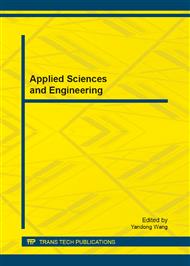[1]
K. Hauser, T. Bretl, K. Harada and J. C. Latombe, Using Motion Primitives in Probabilistic Sample-Based Planning for Humanoid Robots, in Workshop on the Algorithmic Foundations of Robotics, (2006).
DOI: 10.1007/978-3-540-68405-3_32
Google Scholar
[2]
K. Harada, S. Hattori and H. Hirukawa, Motion Planning for Walking Pattern Generation of Humanoid Robots, in IEEE/RSJ International Conference on Intelligent Robots and Systems, pp.4227-4233, (2007).
DOI: 10.1109/iros.2007.4399209
Google Scholar
[3]
J. Kuffner, K. Nishiwaki and S. Kagami, Footstep Planning Among Obstacle for Biped Robots, in IEEE International Conference on Intelligent Robots and Systems, pp.500-505, (2001).
DOI: 10.1109/iros.2001.973406
Google Scholar
[4]
L. E. Kavraki, P. Svestka, J. C. Latombe and M. H. Overmars, "Probabilistic roadmaps for fast path planning in high-dimensional configuration spaces, in IEEE Transactions on Robotics and Automation, pp.566-580, (1996).
DOI: 10.1109/70.508439
Google Scholar
[5]
S. M. LaValle and J. J. Kuffner, "Rapidly-exploring random trees: Progress and prospects, in Workshop on Algorithmic Foundation of Robotics, pp.293-308, (2000).
Google Scholar
[6]
H. Liu, W. W. Wan and H. B. Zha, A dynamic subgoal path planner for unpredictable environments, in IEEE International Conference on Robotics and Automation, pp.994-1001, (2010).
DOI: 10.1109/robot.2010.5509324
Google Scholar
[7]
S. Kajita, F. Kanehiro, K. Kaneko, K. Fujiwara, K. Harada, K. Yokoi and H. Hirukawa, Biped Walking Pattern Generation by Using Preview Control of Zero-Moment Point, in IEEE International Conference on Robotics and Automation, pp.1620-1626, (2003).
DOI: 10.1109/robot.2003.1241826
Google Scholar
[8]
K. K. Noh, J. G. Kim and U. Y. Huh, Stability Experiment of a Biped Walking Robot with Inverted Pendulum, in the IEEE Conference of Industrial Electronics Society, pp.2475-2479 , (2004).
DOI: 10.1109/iecon.2004.1432189
Google Scholar
[9]
R. Cupec, G. Schmidt, O. Lorch, Experiments in Vision-Guided Robot Walking in a Structured Scenario, in IEEE International Symposium on Industrial Electronics, pp.1581-1586, (2005).
DOI: 10.1109/isie.2005.1529168
Google Scholar
[10]
J. Chestnutt, M. Lau, G. Cheung, J. Kuffner, J. Hodgins and T. Kanade, Footstep Planning for the Honda ASIMO Humanoid, in IEEE International Conference on Robotics and Automation, p.629, (2005).
DOI: 10.1109/robot.2005.1570188
Google Scholar
[11]
J. Chestnutt, Y. Takaoka, M. Doi, K. Suga and S. Kagami, Safe adjustment regions for legged locomotion paths, in IEEE International Conference on Humanoid Robots, pp.224-229, (2010).
DOI: 10.1109/ichr.2010.5686829
Google Scholar
[12]
M. Philipp, J. Chestnutt, J. Kuffner and T. Kanade, Vision-Guided Humanoid Footstep Planning for Dynamic Environments, in IEEE International Conference on Humanoid Robots, pp.13-18, (2005).
DOI: 10.1109/ichr.2005.1573538
Google Scholar
[13]
J. Chestnutt, Navigation Planning for Legged Robots, [PhD. Thesis], CMU-RI-TR-56-23, Nov. 2007, The Robotics Institute, Carnegie Mellon University, Pittsburgh, Pennsylvania USA.
Google Scholar
[14]
S. Kajita, O. Matsumoto and M. Saigo, Real-time 3D walking pattern generation for a biped robot with telescopic legs, in in IEEE International Conference on Robotics and Automation, pp.2299-2306, (2001).
DOI: 10.1109/robot.2001.932965
Google Scholar
[15]
K. Erbatur, A. Okazaki, K. Obiya, T. Takahashi and A. Kawamura, AStudy on the Zero Moment Point Measurement for Biped Walking Robots, in International Workshop on Advanced Motion Control, pp.431-436, (2002).
DOI: 10.1109/amc.2002.1026959
Google Scholar
[16]
C. Zhu, Y. Tomizawa, X. Luo and A. Kawamura, Biped Walking with Variable ZMP, Frictional Constraint, and Inverted Pendulum Model, in IEEE International Conference on Robotics and Biomimetics, pp.425-430, (2004).
DOI: 10.1109/robio.2004.1521816
Google Scholar


